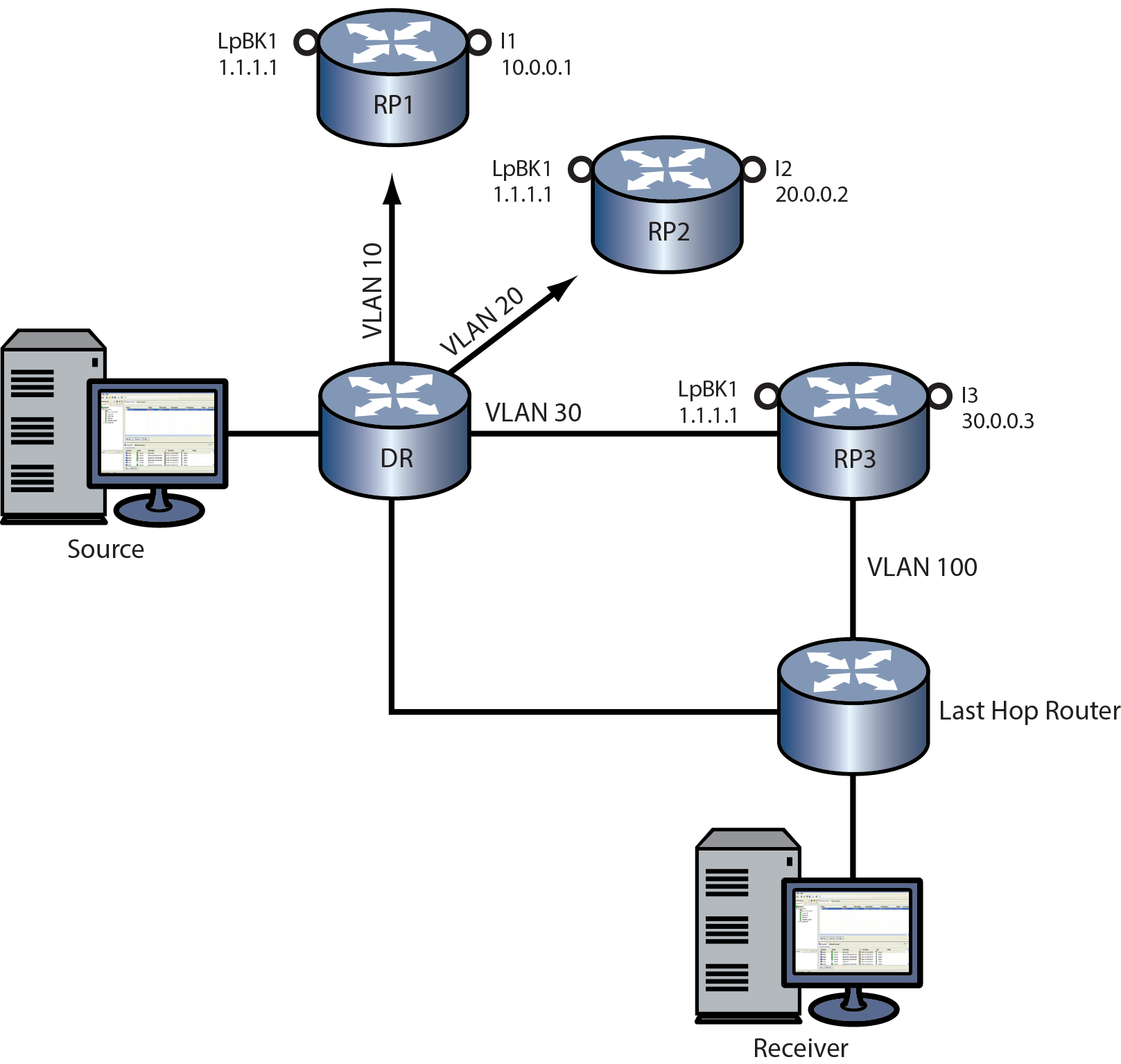Anycast-RP
The S- K- and 7100-Series supports anycast-RP. Anycast-RP provides a means of avoiding a single point of failure through fast convergence when a PIM RP router fails. It also provides for RP load balancing. The relationship between a source or receiver and the PIM RP router is a one-to-one relationship. The relationship between a source or receiver and an Anycast-RP set of routers is a one-to-many relationship, where one of multiple anycast configured RPs is selected by the routing protocol to be the source or receiver PIM RP router.
Anycast-RP provides for the selection of a set of routers to be identified as anycast RPs by
- Configuring each member of the anycast-RP set as either a static RP or a PIM candidate RP using the same loopback anycast IP address as the RP IP address
- Configuring:
- A loopback interface with the same IP address for each anycast-RP router in the set
- Either a second loopback interface or another hardware interface to be configured with a unique address for this peer of the anycast-RP set
Each anycast-RP router is configured with the same anycast-RP address and all the peer-addresses of each router in the anycast-RP router set. A unique peer address is used to allow each member of the anycast-RP set to identify all other members of the set. Each anycast-RP and peer-address combination is configured in its own command line entry using the ip pim anycast-rp command.
The routing protocol determines which member of the anycast-RP router set will function as the PIM RP router. Should the PIM RP router fail, the routing protocol determines the next anycast-RP router that will become the new PIM RP router, based upon the routing protocol‘s routing criteria.
Anycast-RP Configuration illustrates an Anycast-RP configuration example.
RP1
- Create and enable VLAN 10 with IP interfaces
- Configure the underlying unicast routing protocol (OSPF)
- Enable IGMP on VLAN 10
- Configure interface loopback 1 with the anycast-RP address 1.1.1.1/32
- Configure interface loopback 2 with the peer-address 10.0.0.1/32
- Configure 1.1.1.1 as either a static RP using the ip pim rp-address command or an RP candidate using the ip pim rp-candidate command
- Configure RP 1.1.1.1 as an anycast-RP set with the peer-addresses for RP1, RP2, and RP3 using the following commands:
- ip pim anycast-rp 1.1.1.1 10.0.0.1
- ip pim anycast-rp 1.1.1.1 20.0.0.1
- ip pim anycast-rp 1.1.1.1 30.0.0.1
RP2
- Create and enable VLAN 20 with IP interfaces
- Configure the underlying unicast routing protocol (OSPF)
- Enable IGMP on VLAN 20
- Configure interface loopback 1 with the anycast-RP address 1.1.1.1/32
- Configure interface loopback 2 with the peer-address 20.0.0.1/32
- Configure 1.1.1.1 as either a static RP using the ip pim rp-address command or an RP candidate using the ip pim rp-candidate command
- Configure RP 1.1.1.1 as an anycast-RP set with the peer-addresses for RP1, RP2, and RP3 using the following commands:
- ip pim anycast-rp 1.1.1.1 10.0.0.1
- ip pim anycast-rp 1.1.1.1 20.0.0.1
- ip pim anycast-rp 1.1.1.1 30.0.0.1
RP3
- Create and enable VLAN 30 with IP interfaces
- Configure the underlying unicast routing protocol (OSPF)
- Enable IGMP on VLAN 30
- Configure interface loopback 1 with the anycast-RP address 1.1.1.1/32
- Configure interface loopback 2 with the peer-address 30.0.0.1/32
- Configure 1.1.1.1 as either a static RP using the ip pim rp-address command or an RP candidate using the ip pim rp-candidate command
- Configure RP 1.1.1.1 as an anycast-RP set with the peer-addresses for RP1, RP2, and RP3 using the following commands:
- ip pim anycast-rp 1.1.1.1 10.0.0.1
- ip pim anycast-rp 1.1.1.1 20.0.0.1
- ip pim
anycast-rp 1.1.1.1 30.0.0.1
With all anycast-RPs configured, the routing protocol selects RP3 as the RP for this domain based upon its routing criteria. Should RP3 fail, the routing protocol will determine which of the remaining routers in the anycast-RP set will take over as RP. Should the failed router return to an operational state, the routing protocol will determine whether a new PIM RP will be selected based upon current conditions.


 Print
this page
Print
this page Email this topic
Email this topic Feedback
Feedback